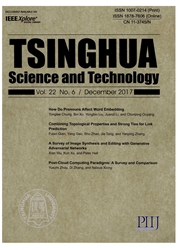

 中文摘要:
中文摘要:
给定计算机网络中的传输控制协议(transmission control protocol,TCP)流量控制算法,如何确定其稳定域,是网络设计中的一个重要问题.由于网络上控制算法受大量随机因素影响,这相当于对一个由随机微分/差分方程描述的控制系统进行稳定性分析.目前已有研究大多直接对系统方程取期望,转为讨论期望的稳定性,而简单忽略受控TCP流的随机震荡.本文意在指出这种随机震荡给稳定性带来的不可忽视的影响.本文以TCP/RED(含早期随机检测的TCP流)系统为例,首先,从系统的随机微分方程出发,通过在平衡点处线性化,将系统化为含加乘混合噪声的多维线性时不变系统.然后,给出了分别对应时间连续与离散情况的推广的TCP流量控制方程,即含多噪声源的一次时不变随机微分/差分方程组.接着,对此推广形式,推导了其协方差矩阵所满足的矩阵方程,并在此基础上,得到了协方差矩阵极限渐近稳定的充要条件以及此极限的计算公式.在工程设计中,此条件可以作为系统稳定与否的一个替代判据,方差极限公式可用来估计系统的运动范围.最后,将一般公式应用到具体例子上,展示了考虑方差稳定性后系统稳定域的变化.进一步,仿照确定性系统中的处理方法,本文结论还可推广到非线性系统及时变系统.
 英文摘要:
英文摘要:
Given the Transmission Control Protocol(TCP) flow control algorithm in a computer network, how to calculate its stability range is an important problem in the design of computer network. Because the control algorithm is affected by many random factors in the network, solving this problem means doing stability analysis for the system described by stochastic differential/difference equations. Current studies mostly take the expectations on both sides of the system equation directly, and simplify this problem into the stability analysis for the expectation, which simply neglects the random variations in the controlled TCP flows. This paper aims at revealing the un-negligible influence from such random variations to the system stability. Using TCP/RED(TCP flows with random early detection) as an example, based on the stochastic differential equations of the system, the system is converted into a multi-dimensional linear time-invariant system with mixed additive and multiplicative noises by linearization at the equilibrium point. Then, generalized TCP flow control equations for continuous-time and discrete-time cases respectively are given, which are the first-degree time-invariant stochastic differential or difference equations with multi-noise-inputs. After that, the covariance matrix equation for such generalized system is derived; and based on this matrix equation, the sufficient and necessary condition when the covariance matrix has an asymptotically stable limit is presented, together with the expression of this limit. In engineering design, this condition can be regarded as a substitute criterion for estimating the motion domain. Finally, this general condition is applied to a specific example for demonstrating the change of the stability range when the stability of covariance is considered. Moreover, the results in this paper can be extended to the nonlinear system or time-varying system when treated by similar methods used in deterministic cases.
 同期刊论文项目
同期刊论文项目
 同项目期刊论文
同项目期刊论文
 HTTP-SCAN: detecting HTTP-flooding attack by modeling multi-features of web browsing behavior from N
HTTP-SCAN: detecting HTTP-flooding attack by modeling multi-features of web browsing behavior from N 期刊信息
期刊信息
